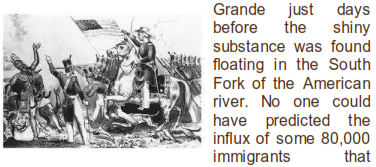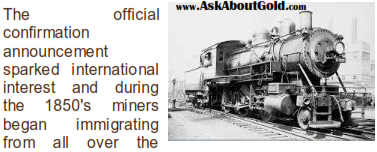The Discovery of Gold
Gold has had the power to enrich communities since its discovery. It was 1848, the war with Mexico was over and Johann Sutter had big plans to build a town of his own. He began by constructing a sawmill meant to handle the large amount of lumber that would be required. He anticipated Suttersville would accommodate a large number of the settlers expected to stream through the Sierra's at any time, now that the animosities had subsided.
While working on the mill's final details, James W. Marshall first discovered the gold flakes that would come to have a huge impact on many. Sutter, no fool, tried to keep the discovery a secret, fearing the derailment of his dreams. Yet there was no holding back the force of greed and rumours that quickly spread. Ironically, Mexico had relinquished its rights to California and all the land north of the Rio

poured into California during 1849.

world; the “forty-niners” had arrived. Although the journey was arduous and fraught with danger, historians estimate the final number of people seeking to strike it rich to be around 300,000. It is thought that the value of the gold garnered from the region exceeded tens of billions of dollars. Most of the searchers went home empty handed yet a select few became millionaires. Many saw the value in California's farmland and chose to stay on and make it their new home.
At first, the positive effects of gold on California's cities weren't noticeable. As Sutter had feared, his plans were ruined, the erection plans for Suttersville were forced to the background, squatters stole his land and cattle and anyone physically capable abandoned his work to frantically search for gold. Numerous ghost towns resulted from the frenzied abandonment of citizens, dreaming of finding their share of gold nuggets, rumored to be plentiful. Hundreds of arriving ships bearing supplies were abandoned by the crew who joined the feverish search.
Native Americans were attacked and pushed off their land and the various methods the gold-seekers employed caused severe environmental damage. Once gold became harder to find, the American miners organized attacks on foreigners in an effort to reap all of the profits. However, once all of the hubbub died down it became apparent that gold had “rushed” California from infancy to a full-blown state. San Francisco grew from a small settlement of a few hundred to a boom-town of 36,000 by 1852.
Many other cities emerged throughout California and progress came to town. Roads, churches, and schools were built. Transportation grew to include steamships and the railroad. Technological advances were made and agriculture and ranching grew to meet the needs of the expanding state. Laws were implemented, claims were staked. A governor was chosen and a constitution was written. This all happened far faster than if the gold rush had not been realized.
Of course, it was the worldwide financial prosperity and economic stability which the bright substance created that began our love affair with gold, which is still going strong tod





